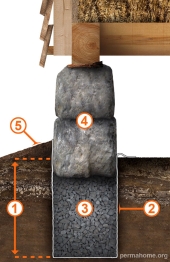
 5
5




 3
3




 5
5




"Ah, but a man's reach should exceed his grasp,
Or what's a heaven for?"
Andrea del Sarto by Robert Browning
 7
7




 8
8




My suburban building and homesteading blog https://offgridburbia.com/
 2
2




"Ah, but a man's reach should exceed his grasp,
Or what's a heaven for?"
Andrea del Sarto by Robert Browning
 1
1




Invasive plants are Earth's way of insisting we notice her medicines. Stephen Herrod Buhner
Everyone learns what works by learning what doesn't work. Stephen Herrod Buhner




Kevin Olson wrote:And, welcome to Permies, John!
If somewhat belatedly...
 5
5




Aaron Yarbrough wrote:If you keep water away from your foundation(by having large roof overhangs, installing gutters, and grading the landscape to move water away from the foundation) I think you will be fine not using geotextile fabric or drain pipe. I've installed drain pipe on the two rubble trench foundations I've done and I'm pretty sure it just gets crushed anyway. As an alternative to geotextile you might consider using burlap instead. It will break down eventually but should help initially to keep sediment out of your rubble trench. Hopefully, by the time it the burlap is compromised you have the roof on and the soil around the site has stabilized so incursion isn't as much of an issue.
 4
4




Glenn Herbert wrote:My land was a farm for something like 150 years before my parents bought it to build their house. Between two fields, essentially huge terraces on a hillside, was a drainage ditch which becomes a ravine. To get between fields the farmer threw rocks into the 5' or so deep gully to make a level driving surface. It still drains through the rock fill after probably 100 years or more. I have never seen the flow overtop the roadway in the heaviest storms.
I think if you start well below frost depth and slope the bottom positively, and use plenty of larger stone with little gravel or sand, you could have a dry footing for a lifetime or more.
 4
4




Kevin Olson wrote:The need for the drain probably depends on: local soil; local terrain; local hydrology; and the type of building you are constructing. And, local building codes will probably trump all of that.
For example, where our house is, the soil is what my neighbor terms a sandy loam, but it's quite sticky when wet. There's enough clay that the surface of the driveway where I park cracks as it dries. For any new construction, I'd want either a perimeter drain or battered (pitched away from the foundation) closed cell insulation, covered with a couple of layers of 6 mil poly sheet, and then back filled. Or both. I've managed to mitigate some leaks through the 1890s-era rock basement wall by doing the foam board and poly sheet trick, though when we get a torrential downpour out of the northeast, we still have a bit of water in the basement. Everything important is on pallets or otherwise not directly on the floor, though, just in case. On the other hand, at our lake property, it's pretty much beach sand, though the water table is high (or the ground is low - depends on your point of reference, I suppose). Out there, any drainage scheme is probably both unnecessary and unhelpful. Anything earth sheltered there will need to have earth bermed up around it, rather than excavating down below grade. And so on,
The Northmen YT channel had a video on building a rock filled trench foundation in a very Permies-friendly and traditional way, which may be worth a watch:
The soil at this site must drain fairly well, since they repeatedly wash sand between the stones by filling the trench with water. Their rye-flour modified mortar is interesting, too.
 4
4




Anne Miller wrote:I have read a lot about rubble trench foundations here on the forum and the use of drain pipe and synthetic geotextile fabric is new to me.
https://permies.com/t/121202/rubble-trench-foundations
 5
5




John Carr wrote:
Anne Miller wrote:I have read a lot about rubble trench foundations here on the forum and the use of drain pipe and synthetic geotextile fabric is new to me.
https://permies.com/t/121202/rubble-trench-foundations
That's interesting, because elsewhere on the web it's always presented as necessary to have liner and a plastic drain at the bottom. E.g. https://www.buildnaturally.com/post/rubbletrench
If it were a shallow foundation and it would be relatively easy to remove the stuff years down the line, I might be willing. But I have to go 5' to get to frost depth and I don't want my grandchildren to have to excavate out a bunch of plastic. I like the idea of a compostable house.
2b. If your permit office requires a drain pipe
Note: Strictly speaking this is a modern addition to rubble trench detailing. But it is simple insurance to make sure that your structure lasts for centuries.
 4
4




John Carr wrote:
Anne Miller wrote:I have read a lot about rubble trench foundations here on the forum and the use of drain pipe and synthetic geotextile fabric is new to me.
https://permies.com/t/121202/rubble-trench-foundations
That's interesting, because elsewhere on the web it's always presented as necessary to have liner and a plastic drain at the bottom. E.g. https://www.buildnaturally.com/post/rubbletrench
If it were a shallow foundation and it would be relatively easy to remove the stuff years down the line, I might be willing. But I have to go 5' to get to frost depth and I don't want my grandchildren to have to excavate out a bunch of plastic. I like the idea of a compostable house.
Invasive plants are Earth's way of insisting we notice her medicines. Stephen Herrod Buhner
Everyone learns what works by learning what doesn't work. Stephen Herrod Buhner
 2
2




 3
3




John Carr wrote:
how do I run the water inlet and septic outlet through the rubble trench foundation? Do I just put it among the rubble and hope it won't get crushed? Or do I need to build a small "basement" from concrete block or something to house the water inlet and outlet?
My suburban building and homesteading blog https://offgridburbia.com/
 3
3




Aaron Yarbrough wrote:
John Carr wrote:
how do I run the water inlet and septic outlet through the rubble trench foundation? Do I just put it among the rubble and hope it won't get crushed? Or do I need to build a small "basement" from concrete block or something to house the water inlet and outlet?
I would run a 3 inch waste water line through a piece of 4" pipe in the area around the trench to protect it. For the water inlet you could do something similar but with a long sweep 90° elbow through the grade beam or build an insulated exterior housing and run the water line in through the wall.
 2
2




John Carr wrote:
I should have mentioned that I'm in the northeast, only an hour and a half from the Canadian border. My water inlet pipe has to be down at about 5' to avoid freezing, so I'm hesitant to make an exterior housing, even if insulated. The water's coming in on the north side of the house so I have to battle the cold where it emerges from the trench.
I'm thinking of putting in a small 'basement' within the edge of the foundation (maybe 5'x5') that I can access through a trap door in the inside floor to turn off the water. But maybe this is not necessary? Otherwise I can just run it up from the trench through the soil, and maybe since it's within the perimeter of the foundation it's not in danger of freezing? I would just insulate the foot or so from the underside of the floor down a foot or two into the soil.
My suburban building and homesteading blog https://offgridburbia.com/
 1
1




"Ah, but a man's reach should exceed his grasp,
Or what's a heaven for?"
Andrea del Sarto by Robert Browning

|
It's fun to be me, and still legal in 9 states! Wanna see my tiny ad?
Freaky Cheap Heat - 2 hour movie - HD streaming
https://permies.com/wiki/238453/Freaky-Cheap-Heat-hour-movie
|







